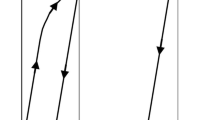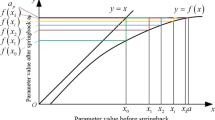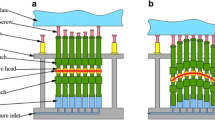Abstract
Aiming at the problem of the springback in the CNC incremental forming, a method for predicting the springback and generating the compensated forming trajectory was proposed based on the explicit and implicit finite element analysis. First, the middle surface of the simulated sheet metal part was reconstructed after the springback simulation with the coordinates of all nodes obtained from the numerical simulations, and the reconstructed middle surface was compared with the middle surface of the theory model to calculate the normal deviation values. Second, the theory model was offset with the unequal distances of the deviation values to generate the compensated facet and the forming path. Once more, the finite element analysis was done until the compensatory effect met the required precision. Meanwhile, aiming at the roughness of the compensated facet caused by the multi-compensation process, the smoothing method was given to guarantee the smooth of the forming path. According to the predicted result of the numerical simulations, three times compensation meets the required precision and the normal deviation value is decreased from 0.696 mm to 0.194 mm. The forming experiments indicate that the springback of the target part in Z direction is decreased from 1.107 mm to 0.427 mm. Therefore, the predicting and compensating method of the springback proposed in the paper is available, which can improve the forming precision of the sheet metal part.



































Similar content being viewed by others
References
Lu B, Fang Y, Xu DK et al (2015) Investigation of material deformation mechanism in double side incremental sheet forming. Int J Mach Tools Manuf 93:37–48
Hamilton K, Jeswiet J (2010) Single point incremental forming at high feed rates and rotational speeds: surface and structural consequences. CIRP Annals-Manufacturing Technology 59(1):311–314
Radu C, Cristea I, Herghelegiu E, Tabacu S (2013) Improving the accuracy of parts manufacturing by single point incremental forming. Appl Mech Mater 332:443–448
Reese ZC, Ruszkiewicz BJ, Nikhare CP, et al (2015) Effect of tool path on the spingback of 2024-T3 aluminum during single point incremental forming: MSEC 2015: proceedings of the ASME 2015 International manufacturing Science and Engineering conference, Charlotte, June 8-12
Zhu H, Fu J, Jiang Z (2009) Generation of spiral tool path for sheet metal CNC incremental forming. Transactions of the Chinese Society for Agricultural Machinery 40(10):223–226
Rauch M, Hascoet J-Y, Hamann J-C, Plenel Y (2009) Tool path programming optimization for incremental sheet forming applications. Comput Aided Des 41(12):877–885
Essa K, Hartley P (2011) An assessment of various process strategies for improving precision in single point incremental forming. Int J Mater Form 4(4):401–412
Ambrogio G, Cozza V, Filice L et al (2007) An analytical model for improving precision in single point incremental forming. J Mater Process Technol 191(1–3):92–95
Zhang Z, Zhang H, Shi Y et al (2016) Springback reduction by annealing for incremental sheet forming. Procedia Manufacturing 5:696–706
Bahloul R, Arfa H, Belhadjsalah H (2013) Application of response surface analysis and genetic algorithm for the optimization of single point incremental forming process. Key Eng Mater 554-557:1265–1272
Yang XA, Ruan F (2011) A die design method for spingback compensation based on displacement adjustment. Int J Mech Sci 53(5):399–406
Zemin F, Mo J, han F, Gong P (2013) Tool path correction algorithm for single-point incremental forming of sheet metal. International Advanced manufacturing Technology 64(9):1239–1248
Erman Tekkaya A, Shankar R et al (2007) Surface reconstruction for incremental forming. Computer Aided Engineering 1(1):71–78
Antonio F, Feriti GC, Ceretti E et al (2014) Development of tool path correction algorithm in incremental sheet forming. Key Eng Mater 622-623:382–389
Xiao S (2012) Research on springback in NC incremental sheet metal forming. Southeast University, Dissertation, Nanjing
Dejardin S, Thibaud S, Gelin JC, Michel G (2010) Experimental investigations and numerical analysis for improving knowledge of incremental sheet forming process for sheet metal parts. J Mater Process Technol 210(2):363–369
Gan W, Mo J (2004) Investigation on spingback of sheet metal numerical control incremental forming. Mechanical Science and Technology 23(6):739–741
Xiuzhi Q, Stucker B (2003) A 3D surface offset method for STL-format models. Rapid Prototyp J 9(3):133–141
Gao J (2011) Sheet metal incremental forming technology. China Machine Press, Beijing
Hu Z, Lin W et al (2015) Study on CNC incremental sectioning and staging forming of sheet metal. Forming and Stamping technology 40(8):5–8
Hao H, Hu R et al (2011) ANSYS 12.0 LS-DYNA nonlinear FEM analysis from introduction to master. China machine press, Beijing
Hu J, Yang X, Zhou Y (2012) A weighted compensation algorithm for normal vector of cutter contact point on triangular mesh surface. China Mechanical Engineering 23(1):1226–1229
Acknowledgements
The authors gratefully acknowledge the financial support from the National Natural Science Foundation of China (No. 51175351) and the Natural Science Foundation of Liaoning Province (No. 2014024011).
Author information
Authors and Affiliations
Corresponding author
Ethics declarations
Conflict of interest
The authors declare that they have no conflict of interest.
Rights and permissions
About this article
Cite this article
Zhu, H., Chang, X. & Jung, D.W. The generation of the forming path with the springback compensation in the CNC incremental forming. Int J Mater Form 11, 455–470 (2018). https://doi.org/10.1007/s12289-017-1355-6
Received:
Accepted:
Published:
Issue Date:
DOI: https://doi.org/10.1007/s12289-017-1355-6




